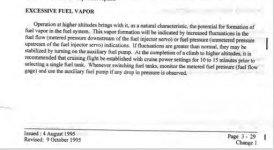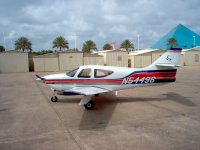Spinhalyard
New member
Addison, TX
- Aircraft Year
- 1976
- Aircraft Type
- 114 Hot Shot
- Reg Number
- N56CV
- Serial Number
- 14017
The 2017 COG Fly-In was the first event of it’s kind I’ve ever attended. I met several great people, learned a lot about Commanders, a few things about my own plane, and even a little about myself.
Cards on the table, I’m probably one of the lowest-time Commander owners in the group, with only 240 hours in my log book, and off that, only 106 are in my 114 (after the first year). Suffice to say, the trip from Dallas to Ft. Collins was to be the longest solo, cross-country I’ve taken. Of course, for such a trip, I wanted to verify the turbo was working well, so another personal record was shattered as I flew at 16,500 there, and 17,500 back. Getting my little Beechcraft Sundowner to 7,000 seemed to take forever, so I was ready to test my latest conveyance. This led to another first, needing oxygen and wearing a nose-hose. Also, up until this point, all of my flying has been at damn-near sea level, making a trip to Colorado the highest elevation patterns and landings I would execute, yet another first. Finally, for no other reason than I wanted to do it without my instructor, I practiced instrument approaches when I landed for fuel. So, all-in-all, more personal firsts and broken records in a single trip than I could have imagined.
The event itself was enjoyable, enlightening, and worth the time, effort, and money to attend. I feel as if fast friends were made, that I look forward to seeing again at the next fly-in. Jim Richards was especially helpful resolving a brake issue, in short order, that would have grounded me until at least Monday. That brake snafu would not be the only equipment issue I would have on the way home. It is important to mention that Jim was already seated in his plane and about to start up and head home when I walked up and asked for help. Without any hesitation, he was out of the plane and providing assistance. Thanks Jim!
One thing of particular interest learned on this trip was that above 15,000, the boost pump should remain on. I, unofficially, learned this while troubleshooting a rough running engine after leveling off at 16,500. It was only after speaking with Todd did I learn, officially, that it must be turned on at higher altitudes. So, what does this have to do with the story? Well, as a result, the boost pump had likely not been run for such a long duty cycle (several hours at a time) in quite a while, if ever. As I got closer to Dallas, and not wanting to pay $7.00ish a gallon at my home airport, $3.85 at Gainesville (45 miles from home as the crow flies) was looking pretty good. After filling up, I turned on the boost pump and before I could turn it off, the switch tripped, and continued to trip. There I sat, minutes from home (in an airplane, anyway), that would not start while thinking to myself, “You have got to be kidding me!”
Fortunately, my wife was there within an hour and a half to pick me up. Unfortunately, the pump had indeed failed and I had to order another one. The somewhat good news is that my shop sold me a new one (not rebuilt) at cost. The shop on the field was going to charge me even more for a rebuilt one. Three days later, an AP buddy of mine and I drove back to Gainesville and installed the new pump. Thursday, eight days after the journey began, I finally completed the flight home from the COG Fly-In.
Oh, and what did I learn about myself on this trip? At 16,500 feet, when the engine is running rough, I’m not as cavalier about being shuffled off this mortal coil as I thought. By George, I want to live to fly another day, and definitely to another COG fly-in.
Cards on the table, I’m probably one of the lowest-time Commander owners in the group, with only 240 hours in my log book, and off that, only 106 are in my 114 (after the first year). Suffice to say, the trip from Dallas to Ft. Collins was to be the longest solo, cross-country I’ve taken. Of course, for such a trip, I wanted to verify the turbo was working well, so another personal record was shattered as I flew at 16,500 there, and 17,500 back. Getting my little Beechcraft Sundowner to 7,000 seemed to take forever, so I was ready to test my latest conveyance. This led to another first, needing oxygen and wearing a nose-hose. Also, up until this point, all of my flying has been at damn-near sea level, making a trip to Colorado the highest elevation patterns and landings I would execute, yet another first. Finally, for no other reason than I wanted to do it without my instructor, I practiced instrument approaches when I landed for fuel. So, all-in-all, more personal firsts and broken records in a single trip than I could have imagined.
The event itself was enjoyable, enlightening, and worth the time, effort, and money to attend. I feel as if fast friends were made, that I look forward to seeing again at the next fly-in. Jim Richards was especially helpful resolving a brake issue, in short order, that would have grounded me until at least Monday. That brake snafu would not be the only equipment issue I would have on the way home. It is important to mention that Jim was already seated in his plane and about to start up and head home when I walked up and asked for help. Without any hesitation, he was out of the plane and providing assistance. Thanks Jim!
One thing of particular interest learned on this trip was that above 15,000, the boost pump should remain on. I, unofficially, learned this while troubleshooting a rough running engine after leveling off at 16,500. It was only after speaking with Todd did I learn, officially, that it must be turned on at higher altitudes. So, what does this have to do with the story? Well, as a result, the boost pump had likely not been run for such a long duty cycle (several hours at a time) in quite a while, if ever. As I got closer to Dallas, and not wanting to pay $7.00ish a gallon at my home airport, $3.85 at Gainesville (45 miles from home as the crow flies) was looking pretty good. After filling up, I turned on the boost pump and before I could turn it off, the switch tripped, and continued to trip. There I sat, minutes from home (in an airplane, anyway), that would not start while thinking to myself, “You have got to be kidding me!”
Fortunately, my wife was there within an hour and a half to pick me up. Unfortunately, the pump had indeed failed and I had to order another one. The somewhat good news is that my shop sold me a new one (not rebuilt) at cost. The shop on the field was going to charge me even more for a rebuilt one. Three days later, an AP buddy of mine and I drove back to Gainesville and installed the new pump. Thursday, eight days after the journey began, I finally completed the flight home from the COG Fly-In.
Oh, and what did I learn about myself on this trip? At 16,500 feet, when the engine is running rough, I’m not as cavalier about being shuffled off this mortal coil as I thought. By George, I want to live to fly another day, and definitely to another COG fly-in.


